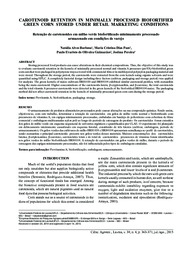Carotenoid retention in minimally processed biofortified green corn stored under retail marketing conditions.
Carotenoid retention in minimally processed biofortified green corn stored under retail marketing conditions.
Author(s): BARBOSA, N. A.; PAES, M. C. D.; GUIMARAES, P. E. de O.; PEREIRA, J.
Summary: ABSTRACT - Storing processed food products can cause alterations in their chemical compositions. Thus, the objective of this study was to evaluate carotenoid retention in the kernels of minimally processed normal and vitamin A precursor (proVA)-biofortified green corn ears that were packaged in polystyrene trays covered with commercial film or in multilayered polynylon packaging material and were stored. Throughout the storage period, the carotenoids were extracted from the corn kernels using organic solvents and were quantified using HPLC. A completely factorial design including three factors (cultivar, packaging and storage period) was applied for analysis. The green kernels of maize cultivars BRS1030 and BRS4104 exhibited similar carotenoid profiles, with zeaxanthin being the main carotenoid. Higher concentrations of the carotenoids lutein, ?-cryptoxanthin, and ?-carotene, the total carotenoids and the total vitamin A precursor carotenoids were detected in the green kernels of the biofortified BRS4104 maize. The packaging method did not affect carotenoid retention in the kernels of minimally processed green corn ears during the storage period. RESUMO - O armazenamento de produtos alimentícios processados pode causar alterações na sua composição química. Sendo assim, objetivou-se, com este trabalho, determinar a retenção de carotenóides em grãos de milho verde normal e biofortificado com precursores de vitamina A, em espigas minimamente processadas, embaladas em bandeja de poliestireno com cobertura de filme comercial e embalagem multicamadas nylon poli ao longo do período de estocagem do produto. Os carotenóides foram extraídos dos grãos de milho verde em esquema sequencial de solventes orgânicos e quantificados por CLAE. O experimento foi planejado em delineamento inteiramente casualizado em esquema fatorial, constituído de três fatores (cultivar, embalagem, período de armazenamento). Os grãos verdes das cultivares de milho BRS1030 e BRS4104 apresentam semelhança no perfil de carotenóides, sendo zeaxantina o principal carotenoide presente nos grãos verdes desses materiais. Maiores concentrações dos carotenóides luteína, β-criptoxantina, β-caroteno, carotenóides totais e do total de carotenóides precursores de vitamina foram identificadas nos grãos verdes do milho biofortificado BRS4104. A retenção de carotenóides em grãos verdes de milho, durante o período de estocagem das espigas minimamente processadas, não foi influenciada pelos tipos de embalagens estudadas.
Publication year: 2015
Types of publication: Journal article
Unit: Embrapa Maize & Sorghum
Keywords: Armazenamento, Biofortificação, Embalagem, Provitamina A
Observation
Some of Embrapa's publications are published as ePub files. To read them, use or download one of the following free software options to your computer or mobile device. Android: Google Play Books; IOS: iBooks; Windows and Linux: Calibre.
Access other publications
Access the Agricultural Research Database (BDPA) to consult Embrapa's full library collection and records.
Visit Embrapa Bookstore to purchase books and other publications sold by Embrapa.

